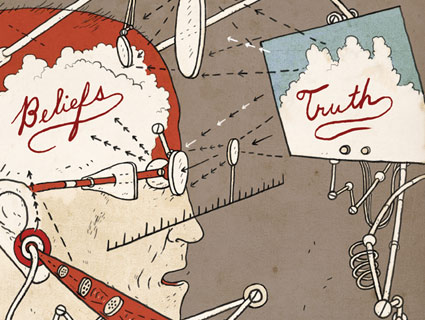
The fan's not gonna help.Shutterstock
Purdue University climatologist Matthew Huber gets plenty of death threats, but that hasn’t stopped him from exploring the outer limits of just how much global warming human beings can tolerate. Whatever our recent Great American Heat Wave (update: make that heat waves) may or may not portend, most credible climate scientists agree that human-caused global warming is real—oh, yes they do!—and most of the research out there, Huber says, predicts dire consequences for people (and other mammals) if average global temperatures rise by 6°C or more.
That could well happen this century: By 2100, Huber points out, the mid-range estimates predict a rise of 3°C to 4°C in average global temperatures based on current economic activities, but those studies ignore accelerating factors like the release of vast quantities of methane—a potent greenhouse gas—now trapped beneath permafrost and sea ice that’s becoming less and less permanent. Other models foresee rises in the 10°C range this century; at the outer fringe, predictions range as high as 20°C. Truth is, we simply don’t know exactly when we’ll reach these milestones or what they will cost us. And thanks to the uncertainty, it’s been hard to get nations to agree on limits.
All of this got Huber and Steven Sherwood, his colleague at Australia’s University of New South Wales, to thinking: Economic considerations aside, they asked, how much warming can we physiologically tolerate? At what point does it get so bad that our bodies can no longer keep cool, so bad that we can no longer work or play sports or even survive for long out of doors?
The pair crunched the numbers and published the results in a May 2010 paper in the Proceedings of the National Academy of Sciences. Using a measurement called “wet-bulb temperature,” which Huber explains below, they modeled what might happen in several warming scenarios. At the point where the average global temperature rise hits 10°C, “even Siberia reaches values exceeding anything in the present-day tropics” and many populated parts of the globe might become, if habitable at all, places where the relatively affluent would likely find themselves “imprisoned” in air-conditioned spaces and where “power failures would become life-threatening.” Lacking access to AC, the world’s poor would have little choice but to flee. Even “modest” global warming, Huber and Sherwood conclude, could “expose large fractions of the population to unprecedented heat stress.”
Their paper makes for a good wish-it-were-sci-fi read for the scientifically inclined. For everyone else, the heat waves we’ve been experiencing provided the perfect excuse to grill Huber on his underlying assumptions, the hate mail he gets, and whether humans can evolve or air condition our way out of this prawndiddity. That’s a word my kids came up with to describe this type of situation, and I’ll roll with it, since our fiasco is theirs to inherit.
First of all, is there anything you’d like to say about the recent heat wave?
It just goes to show you how random weather can be. It tells us about as much by itself as the occasional unseasonable cold snap. It is useful, however, as an analogy for what the future climate might look like. When climate modelers say that spring might start a month earlier on average this sounds abstract to most people, but the recent weather provides a good tangible example of what statements like this mean.
Are there currently places on Earth where average temperatures are beyond the ability of our bodies to stay cool?
In the shade, with plenty of water and ventilation, acclimated healthy adults can survive just about everywhere currently, assuming that they aren’t exerting themselves. On the other hand, when physical exertion, sunlight, improper hydration, poor ventilation, lack of acclimatization, and other health conditions (including being very young or old) are a factor, many regions can experience severe enough heat stress that serious consequences arise. Every time someone gets heat stroke, that’s someone who pushed themselves or were pushed by circumstance outside of their zone for regulating their temperatures. There is a wide zone over which people can adjust their behavior to withstand very warm conditions. Our paper asked the question: Is there a limit to that adaptability, and, if so, how hot does the world have to get before we reach that limit?
How would you characterize your underlying assumptions?
We intentionally were trying to explore the upper limit of what humans can possibly stand. Essentially we were assuming a perfectly acclimated person, in perfect health, not performing physical labor, and out of the sun, and were then asking, “What would it take to kill them quickly?” A real person would be profoundly uncomfortable, miserable, and/or sick long before we reach the limit discussed in our paper. Infants, pregnant women, and the elderly would be especially vulnerable long before we hit the limit discussed.
Thus the global mean temperature increase of about 10°C that causes widespread heat death in our paper probably is a significant overestimate of the threshold at which substantial harm [would come] to societies and individuals would suffer harm and/or reduced productivity. Put in more prosaic terms, large parts of the world would be violating OSHA and international health standards for work long before we approach this 10°C threshold. But we wanted to be sure we had a limit set by physical and thermodynamic laws and not by human ones (since those are mutable).
Your conclusions are based on a measurement known as “wet-bulb temperature,” which refers to a thermometer bulb, wrapped in wet cloth and ventilated. What does it mean in human terms?
In practice, the wet-bulb temperature we calculated would correspond to a naked, healthy adult standing in the shade with gale force winds blowing on them while they were drinking gallons of water. Any deviation from that perfect scenario would increase the heat stress on an individual.
What kind of feedback has your paper received?
I get hate mail and death threats on a regular basis. I’m used to that. I didn’t notice much of an uptick with publication of this paper. (I just delete those emails anyway.) Within the scientific community, the response has been initial caution and skepticism (which is warranted) from many of my colleagues followed by the rather interesting and disturbing conclusion I have heard repeated many times: “We sat down to figure out what was wrong in the paper—because there had to be something wrong—and we haven’t been able to find any errors, so it appears to be correct”. The paper is getting heavily cited, and not because it’s wrong.
The only quasi-scientific argument I have heard, and it is wrong on the facts, is that some magical thermostat limits tropical temperatures so that the scenario in our simulations can’t happen. I’ve spent my entire academic career looking for thermostats and not found any. Alas, there is magical thinking among scientists as well. I have seen some commentary by nonscientists on blogs and most of them say that I’m just another “cap-and-tax” green freak who wants big government and to outlaw guns. This is an unfortunate and inaccurate reading of our paper’s intent, since we offer no policy prescription in that paper and ultimately the overall problem is so big that we need to get past knee-jerk responses.
Practically speaking, do we have bigger fish to fry? In other words, will the problems we’ll encounter en route to 10 degrees warming be so dire that all of this becomes moot? I’m thinking of things like massive crop failures, collapse of the food chain, etc.
Society probably has many more pressing issues at the moment to worry about: famine, disease, poverty. Perhaps paradoxically, that is one of my driving motivations for publishing of this study. Short-term disasters are difficult to plan for, so planning is most useful in slow moving disasters. For example, it is difficult to know whether the car in front of you is going to slam on its brakes. Once it does, you are in crisis mode and you must make decisions based on road conditions and speed accordingly. But certainly, in the future, with lessons learned the hard way, you might make decisions like buying a car with ABS breaks and perhaps increase the spacing between you and the car ahead. The world needs to start learning to avoid the avoidable, and that means planning ahead, because otherwise you run from crisis to crisis.
It is debatable whether the world can avoid a 2°C global warming. Many people argue that this is a limit that must not be crossed. Unfortunately, in my personal opinion, that train has left the station. We need to be asking the more difficult and ultimately more productive question, “Are there climatic conditions that we can all agree we want to avoid, and if so, what temperature characterizes that state—5°C warmer than today, 10°C?” Rather than setting very stringent limits that are both unlikely to be met and with a narrow base of support—a route to inaction—it makes more sense to ask, “What’s the minimum temperature change we would all like to avoid,” and then work down from that number. This has the advantage of allowing everyone to focus on what they have in common. (I don’t think anyone wants to see millions of people dying in the streets from heat stroke.) And it also gives us sufficient time to do something about it. Perhaps we can all agree that global warming should definitely be limited to less than 6°C and we can have a broad base of support for that statement and make forward progress. I’m not saying that 6°C is truly safe either, because I don’t know. But 10°C is definitely too hot and 2°C is a lost cause.
As global temperatures rise, people will resort to more air conditioning. To what degree will that energy-consumption feedback loop accelerate the warming?
The increased use of air conditioners is likely to have large deleterious impacts. The heat flux—into the “urban canyon”—in cities from the effluent of air conditioners will be substantial and add to the urban heat-island effect. The increased use of the power grid during peak hot conditions will place substantial and highly variable load on an already strained system. The power for the air conditioning has to come from somewhere, and for much of the world this means more burning of fossil fuels.
What happens to the rest of the creatures that don’t have access to air conditioning, or maybe don’t have any way to reach—or adapt well to—cooler areas?
Burrow. Be active at night. Stay near bodies of water. Reduce activities to a minimum. Lower birth weight.
If we do ever reach 12 degrees warming, what might that look like on the ground? Give me your sci-fi movie scenario.
My nightmare. I’m in Oklahoma on a hot summer day. Under a heat lamp. Running. Wrapped in plastic.
This could clearly be a selective biological pressure on humans. Would we end up eventually evolving to deal with greater heat, as you report that mammals did during the Eocene era?
The most direct way for humans to respond physiologically, which would take thousands of years if at all (we are most likely to change our behaviors) is to get small and skinny, to decrease our volume and maximize our surface area so we can lose heat more effectively.
Will current models hold up once we get to temperatures that high? Or might other factors come into play that we haven’t anticipated? Clearly there are warming factors, such as release of trapped methane from Arctic ice; are there also potential cooling feedback factors, such as increased air pollution reflecting back sunlight, or things of that nature?
The models aren’t perfect. The thing to ask is, are they biased to produce a world that is too warm or too cold in the future? For 30 years, climate modelers have compared simulations of past climate change (glacial intervals, greenhouse climates such as the Eocene) against data and found that models get the general climate right but that they are systematically biased to be somewhat too insensitive to forcing. In other words, what modeling of past climates tells us is that these models are—if anything—biased to underpredict future climate change.
The Newt Gingrich’s of the world might say: Hey, 2100 is totally distant. New technology will save us. Discuss.
Newt, interestingly is the most future-minded of the bunch, but unfortunately his attitude toward problems like this tends toward the eschatological. He wants us to colonize space since we are destroying our current planet. I think that with enough time and focus technology can indeed save us. But the only way that will happen is if we are focused on a common and very real goal. Technology blossoms when it fills a need. We need to agree on the need. If we can’t agree on avoiding a 2°C warming, perhaps we can agree on 6°C or 10°C. What matters is reaching agreement on something and moving ahead.
















